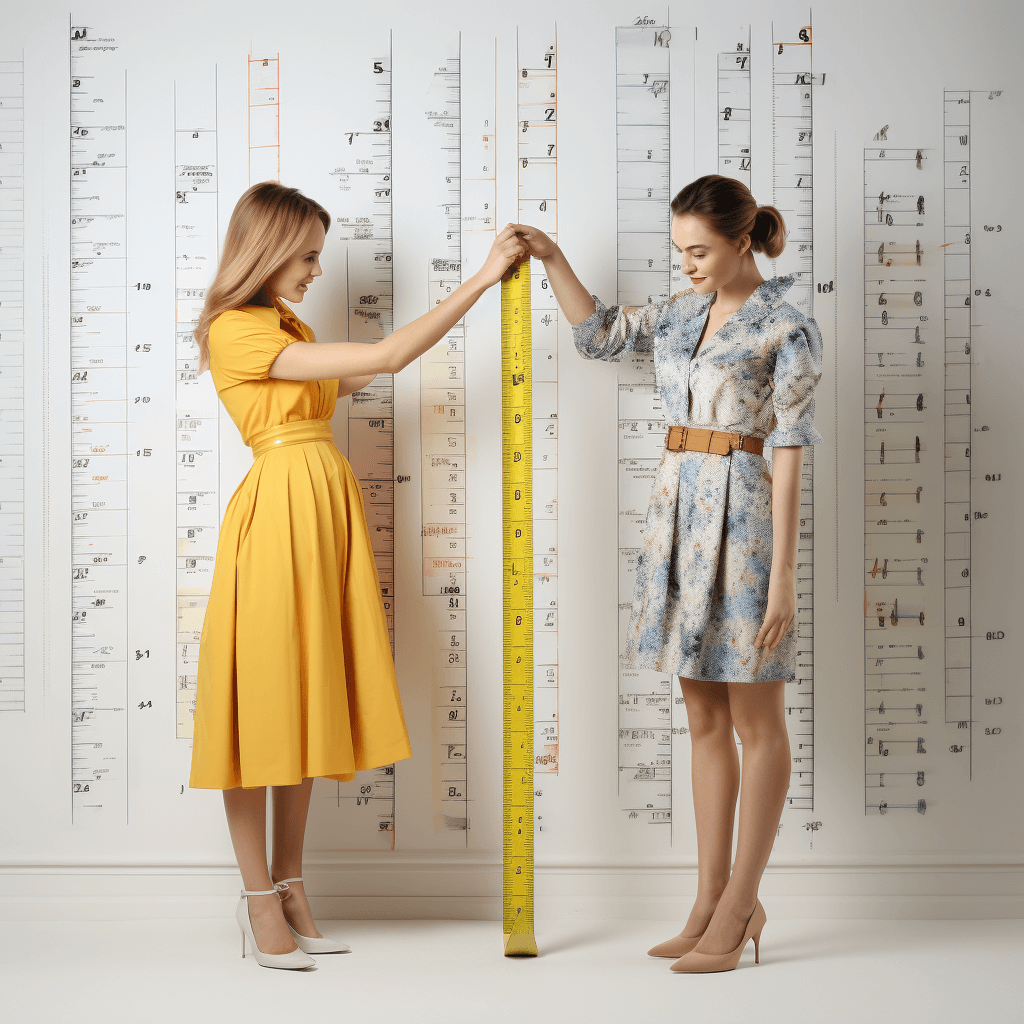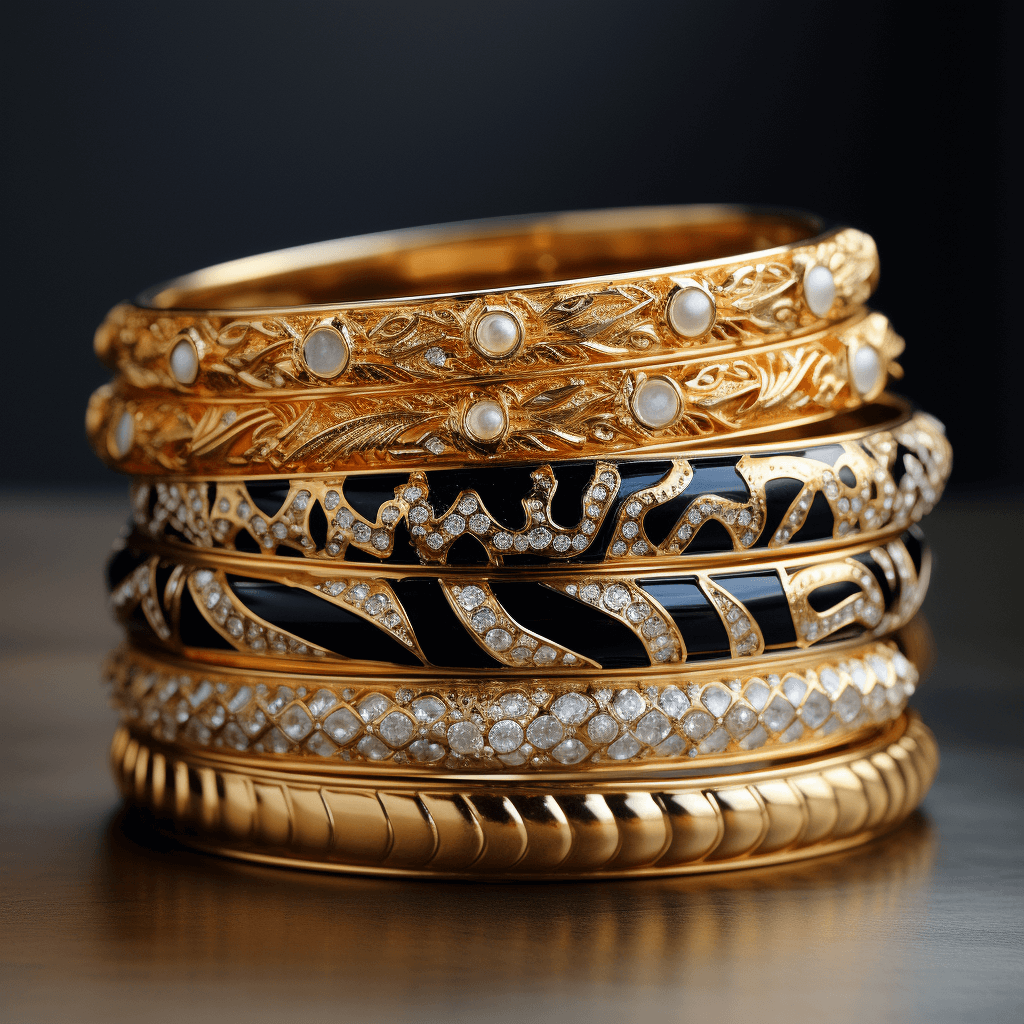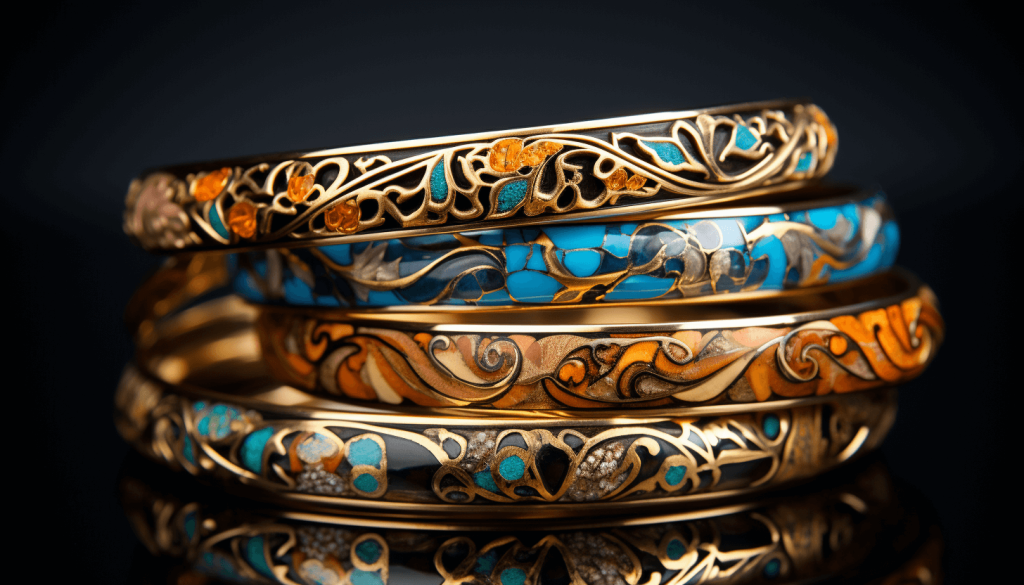The Importance of Correct Bangle Sizing
Bangles are a beautiful and timeless addition to any jewelry collection. They can be worn singularly for a simple, elegant look, or stacked together for a fun and fashionable statement. However, unlike bracelets, bangles are not adjustable and therefore need to be sized correctly to ensure they fit comfortably on your wrist without falling off. A poorly sized bangle can be uncomfortable, distracting, and even at risk of being lost. In this guide, we will walk you through the steps on how to measure your wrist correctly for the perfect bangle size.
Did you know? Bangle sizes are often determined by the size of your hand and not your wrist. This is because the bangle needs to pass over your hand to reach your wrist.
Understanding Bangle Sizes: The Standard Chart
Just like other jewelry, bangles come in various sizes. It’s essential to know your size for a comfortable and secure fit. Below is a table that provides a general guide for bangle sizes and their corresponding measurements in both inches and centimeters.
| Bangle Size | Diameter (Inches) | Diameter (Centimeters) | Circumference (Inches) | Circumference (Centimeters) |
|---|---|---|---|---|
| Petite | 2.25″ | 5.7cm | 7.06″ | 17.93cm |
| Small | 2.37″ | 6.03cm | 7.46″ | 18.95cm |
| Medium | 2.50″ | 6.35cm | 7.85″ | 19.94cm |
| Medium Plus | 2.62″ | 6.66cm | 8.24″ | 20.93cm |
| Large | 2.75″ | 6.98cm | 8.64″ | 21.92cm |
| X-Large | 2.87″ | 7.29cm | 9.02″ | 22.91cm |
| XX-Large | 3.00″ | 7.62cm | 9.42″ | 23.91cm |
What You’ll Need to Measure Your Wrist for a Bangle

Measuring your wrist for a bangle is a straightforward process that requires just a few common items. You won’t need any special equipment, just a few things that you probably already have around your home. Here’s what you’ll need:
- Flexible Measuring Tape: A flexible measuring tape is the best tool for taking your wrist measurement. It’s flexible enough to wrap around your wrist and accurate enough to give you the correct measurement.
- Strip of Paper: If you don’t have a flexible measuring tape, a strip of paper can work in a pinch. You’ll just wrap the paper strip around your wrist, mark the paper where it overlaps, and then measure the length of the strip up to the mark using a ruler.
- Ruler: If you’re using a strip of paper to measure your wrist, you’ll need a ruler to measure the length of the strip after you’ve marked it. A ruler with both inches and centimeters will provide the most flexibility.
- Pen: A pen or pencil is useful for marking the paper strip when taking your wrist measurement.
Step-by-Step Guide: Measuring Your Hand for a Bangle Size
As previously stated, determining your bangle size requires a slightly different approach than measuring for a bracelet. Because of the solid structure of a bangle, you must ensure it can pass over your hand. Here is a simple guide to measure your hand for the perfect bangle fit:
- 1. Prepare Your Hand: Start by closing your hand as if you are putting on a bangle, bringing your thumb and little finger together.
- 2. Wrap the Measuring Tool: Using your flexible tape measure or paper strip, wrap it around the widest part of your hand (around the knuckles and thumb base).
- 3. Take the Measurement: Mark the spot where the tape or paper strip meets the start. If you’re using a flexible tape measure, take note of the measurement. If you’re using a paper strip, lay it flat and measure it up to the mark with your ruler.
- 4. Consult the Bangle Size Chart: Now that you have the circumference of your hand, refer back to the bangle size chart to determine your corresponding bangle size.
Note: It’s best to repeat the measuring process a few times to ensure the accuracy of your measurements. Variations can occur, and an average measurement often offers the most reliable sizing.
How to Ensure Accurate Measurements for Your Bangle
Even with a step-by-step guide, taking measurements can sometimes be tricky. But don’t worry—we’re here to help you get the most accurate bangle measurements possible. Here are some helpful tips:
- Don’t Pull the Tape Too Tight: When you’re measuring, wrap the tape or paper strip around your hand snugly but without compressing your skin. The measurement you want is your actual hand size, not its size when squeezed.
- Measure More Than Once: It’s always a good idea to measure a couple of times to make sure you’ve got an accurate measurement. Our bodies can change slightly throughout the day, so taking a few measurements can help you get a more accurate average size.
- Consider Comfort: While getting the right bangle size is essential, so is comfort. If you’re in between sizes, it’s often better to go for the larger size to ensure the bangle is comfortable to wear and easy to put on and take off.
- Keep Seasonal Changes in Mind: Remember that our hands can swell in hot weather and shrink in cold weather. If you’re measuring in extreme temperatures, this could affect your bangle size. Consider this when deciding on your size, especially if you’re between sizes.
- Consider Bangle Width: Thicker bangles tend to fit more snugly than thinner ones. If the bangle you’re choosing is wide, you might want to consider going up a size to ensure it doesn’t fit too tightly.
Remember, the key to a well-fitting bangle is a balance of size, comfort, and style. By following these tips, you can ensure your bangle will be a joy to wear—adding a touch of elegance to your outfits and giving you the confidence that it won’t slip off your wrist.
Different Types of Bangles and Their Sizing Standards

Bangles come in an array of styles, materials, and designs, each with its own sizing considerations. Understanding these can help you choose a bangle that not only fits well but also complements your style. Here are a few types of bangles and their respective sizing standards:
- Metal Bangles: These are rigid bracelets usually made from metals like gold, silver, copper, or brass. Their size is determined by the diameter and cannot be adjusted after purchase. For this reason, it’s crucial to get an accurate hand measurement before buying.
- Resin and Wood Bangles: Like metal bangles, these are also rigid and non-adjustable. They may come in slightly larger sizes due to the nature of their materials and design.
- Open Cuff Bangles: These are semi-flexible bangles that have a small opening, which allows for some adjustability. Because they can be slightly adjusted, cuff bangles offer a bit more flexibility in sizing.
- Charm Bangles: These are usually adjustable bangles with charms or pendants attached. They often have a sliding mechanism that allows you to customize the fit to your wrist size.
- Beaded Bangles: These are flexible bracelets made from beads strung together. They’re usually sized by length rather than diameter, so you might need to measure your wrist circumference instead of your hand for these.
Regardless of the type of bangle you choose, getting an accurate hand measurement is key. Knowing your size and the particular sizing considerations of each bangle style will help you find a piece that fits well and looks stunning.
How Should a Bangle Bracelet Fit: Style vs. Comfort
A well-fitting bangle can elevate your style while providing comfort for day-long wear. But how should a bangle bracelet actually fit? Well, it depends on both the style of the bangle and your personal comfort.
- Comfort: A bangle should be large enough to slide over your hand easily but not so large that it slips off when your hand is hanging down. It should also be loose enough to move on your wrist, but not excessively so.
- Style: Some people prefer their bangles to fit snugly so they stay in place, while others prefer a looser fit for a more relaxed look. Stackable bangles are often worn a bit looser to allow them to move and jingle, while statement bangles might be worn tighter so they stay in the spotlight.
Ultimately, the right fit for a bangle bracelet is a personal decision that balances style and comfort. As long as your bangle is not too tight to restrict movement or too loose to risk falling off, you can choose a fit that suits your style and comfort preferences.
Adjusting Bangle Sizes: Options after Purchase
So you’ve measured your hand, chosen your bangle, and now you have it in your possession, but it doesn’t fit quite right. What can you do now?
- Resizing: Depending on the type and material of the bangle, it might be possible to have it resized. This is typically more feasible for metal bangles than those made of wood, resin, or beads. Resizing usually involves cutting and soldering the bangle, so it’s a job for a professional jeweler.
- Adding Material: For bangles that are too large, it might be possible to add extra material inside the bangle to make it fit more snugly. This could involve adding extra beads to a beaded bangle or adding a lining to a metal or resin bangle.
- Exchanging: If resizing or adding material isn’t feasible or doesn’t achieve the desired fit, exchanging the bangle for a different size might be an option. Check the seller’s exchange policy before purchasing to ensure this is a possibility.
- Layering: If a bangle is a bit too large but still wearable, consider layering it with other bracelets or bangles. This can not only help keep the bangle in place but also create a stylish, layered look.
Remember, it’s essential to get your measurements as accurate as possible before purchasing a bangle to minimize the need for adjustments later. However, if you do end up with a bangle that doesn’t fit quite right, these tips can help you achieve a better fit.
Selecting the Right Bangle Size: For Yourself or As a Gift
Choosing the right bangle size can seem daunting, but with the proper measurements and understanding of bangle sizing standards, you can confidently select the perfect bangle for yourself or as a gift.
- For Yourself: Measure your hand as per the instructions provided in this guide. Then, refer to the standard bangle size chart and find the size that best matches your measurement. Consider both your comfort and style while making the final decision.
- As a Gift: If possible, discreetly measure the recipient’s hand using the method outlined above. If that’s not feasible, consider asking them their size directly or try to get information from someone close to them. If all else fails, choosing a medium size is usually a safe bet as most bangle styles offer some level of adjustability.
Remember, the goal is to find a bangle that looks great, feels comfortable, and brings joy to the wearer!
Frequently Asked Questions about Bangle Sizing
How much larger should a bangle be than your wrist?
Generally, a bangle should be about 1 inch larger than the circumference of your wrist. However, personal preference and the style of the bangle can influence the ideal size.
Can a jeweler resize a bangle?
Yes, a professional jeweler can often resize a metal bangle. The process usually involves cutting and soldering the bangle. However, this might not be possible for bangles made from wood, resin, or beads.
How should a bangle bracelet fit?
A bangle bracelet should be large enough to slide over your hand but not so loose that it risks falling off. It should have some movement on your wrist but not enough to cause discomfort. Ultimately, the right fit depends on your comfort and style preferences.
What is the standard bangle size for a woman?
The standard bangle size for women typically falls between medium and large, which translates to a diameter of about 2.25 to 2.5 inches or a circumference of about 7.5 to 8 inches. However, these are just averages, and the actual size can vary significantly from person to person.
Can you resize bangles?
Resizing a bangle is generally more complicated than resizing a ring because it involves altering the entire circumference. While it is possible in some cases, not all materials or designs can be easily resized. It’s always recommended to consult with a professional jeweler to discuss your options.
What if I’m between bangle sizes?
If you find that your hand measurement falls between two bangle sizes, it’s typically best to go with the larger size. A bangle that’s too tight can be uncomfortable and difficult to put on or remove, whereas a slightly loose bangle still stays on your wrist and offers more comfort.
How should a bangle fit?
A well-fitted bangle should slide onto your wrist easily and have a bit of movement. It should not be so tight that it pinches or restricts your wrist, nor so loose that it slides off your hand when your arm is down. Remember, comfort is crucial when wearing any piece of jewelry.
Conclusion: Enjoy Wearing Your Perfectly Fitted Bangle!
With the knowledge you’ve gained in this guide, you are now ready to choose the perfect bangle size. You know how to measure your hand, interpret a bangle size chart, and what factors to consider while choosing a bangle. From daily wear to special occasions, your bangle should be a symbol of style, grace, and comfort.
Whether you’re buying a bangle for yourself or gifting one to a loved one, you can now be confident in your choice. So, go ahead and enjoy the beauty of a perfectly fitted bangle that complements your style!
Remember: Comfort should always be a priority when choosing a bangle. After all, a jewelry piece that’s uncomfortable to wear is not worth the investment, no matter how attractive it is. Additionally, a bangle’s size can significantly influence its look and feel, so always make sure it’s the right size for you or the intended recipient.

